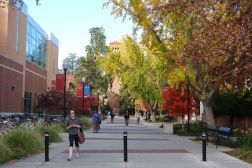Duke IT manager helps integrate the old with the new – while preserving security

Sasha Calden’s role is always changing.
As the IT manager for the biology and evolutionary anthropology departments at Duke University’s Trinity College of Arts and Sciences, she started out providing Apple Mac server and desktop support – and now, she is in the process of helping the entire campus migrate to a cloud-based service.
Calden moved to Duke about eight years ago, after working at Middlebury College in Vermont for a decade, and currently supports about 400 faculty and graduate students in the School of the Arts and Sciences on an annual budget of $70,000. She talked to EdScoop about the challenges she and others like her face integrating old equipment with new software, protecting privacy and decreasing security risks, and the ever-changing nature of college campus IT systems.
Below is an edited and condensed Q & A with Calden:
EdScoop: What were you hired at Duke to do?
Sasha Calden: Our department is one of the largest on the academic side, and we are 80 percent Mac [users], so one of the key things they were looking for me to do was integrate Macs into an active directory environment, which, at the time, not a lot of people had experience with. An active directory environment allows you to update computers automatically and lock down specific settings. So at the time, they were looking for a way to help manage Macs, because Windows and Mac computers don’t really play well together. And at the time, there wasn’t a specific tool at the enterprise level to manage both platforms.
How has your role evolved since?
SC: The previous manager decided to move on, and based on my performance and ideas, I was able to go into a management position. At the time it entailed four staff continuing to support the department. We were continuing to add devices, like anyone else, but we also needed to streamline what support and services we were able to provide on a much more consistent level.
Customer service is my key, and being able to provide the same level of customer service to everyone in the department. It was an uneven match at the time, so I took on the challenge of cross-training the staff. We had very siloed positions – our jobs aren’t based upon the number of tickets we get, but the level of support we provide, and having people be knowledgeable in all areas, as far as Windows versus Mac.
Duke is unique in allowing students to work in its IT department. Can you explain how that works?
SC: I have created a walk-in help desk for our department. It’s comprised of one full-time staff member and between nine to 12 students. It allows anyone to stop by at any time with whatever issues they may be having.
I manage the hiring for the staff and the student help desk. I think we were probably the first department to actually have students supporting faculty and staff. I know within the School of Arts and Sciences, this is the first time we had a help desk that had student workers. We have some computer science majors, and we have a lot from the master’s of engineering program.
Which cloud-based solution are you trying to move towards?
SC: Because we are a unique department, we have our own staff, servers and virtual environment. Those pieces of hardware have come to their end of life, so we’re looking at alternative solutions that are more feasible and cost effective. Duke has a contract with Box; they signed it a couple years ago because they did offer the security settings that met our requirements at the time.
We as a department are looking to move our home directories into a cloud-based service, and Dropbox is something our faculty have voiced very much a preference for. There are some compatibility issues with Mac computers versus Windows when it comes to Box, so we were looking at an alternative solution that might have better cross-platform support. Dropbox has started to meet security requirements that academia needs. They just started getting a footprint in higher education about a year ago, so when they announced that, we started really looking into it.
What does the pilot program look like?
SC: I started a small pilot and we just added a much larger pilot. Originally it was 100 licenses with 50 users in my department, and most were in IT areas and higher executive positions. Everyone is looking at this to see, ‘Does this meet our needs? Does it pass our security requirements?’ We just extended it to a larger pilot with 1,000 licenses, so the larger campus IT can test out the provisioning of accounts and the on-boarding and off-boarding process.
How has the role of IT manager changed?
SC: I guess the difference for me really has been with the way the economy has changed since I first came. Our budget has reduced significantly, and one of the largest roles for me at this point is to look at ways we can be green [sustainable] within our own department and meet security requirements. At Duke previously, security really wasn’t the forefront of how we implemented services and what we were purchasing. That’s not the same environment we have today.
One of the biggest challenges with a research institution is that each lab is funded on their own, with their own budgets. So they purchase their own equipment. It was kind of the Wild Wild West, and now more faculty are looking for support and understanding in the purchases they’re making. Especially in the sciences, there’s equipment that’s 15 years old. It still works fine; however, it has outgrown the software and security requirements. So how do we look at alternative solutions to keep that piece of equipment perfectly fine, but integrated into an updated OS?
How do you protect privacy and ensure security on the network?
SC: Actually, we’re going through the retiring of our virtual environment. A lot of these individual servers which were set up for different researchers to host a database are very old. We have had a number of incidences where there have been machines that have been hacked or compromised. A lot of times it’s because of a vendor-installed piece of software, because we have a lot of equipment that is vendor installed and they have their own specific software. They tend to have software that may let them set up generic log-in accounts, so that has become a real issue for the campus as a whole. Although it may seem very minuscule [if someone hacks into a research database], it actually puts the entire university at risk.
That’s where I work pretty closely and collaboratively with the the larger IT department, to evaluate our systems and look at what it is we need to be doing to mitigate those risks. So we can protect ourselves and also plan for continued growth in this ever-changing technological environment, which I think sometimes can get frustrating more so for the researchers, because in their minds it sometimes hinders their ability to have this open platform.
What makes you excited about the work you’re doing?
SC: I think what makes it the most exciting is being able to deliver exceptional service and continuing to be a life-long learner and have a clear understanding of what our educators and researchers needs are. I really enjoy technology, I love learning new things and being able to ensure that we’re not just adopting that technology but learning to integrate the old with the new. Every day affords a different opportunity for learning, but also working collaboratively with some of the most intelligent people I’ve ever met.





